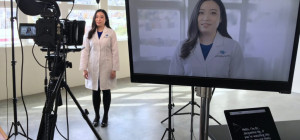 As the Pandemic of 2020 has raged, globally, climbing infection rates have precipitated the need to shelter in place, social distance, and wear masks for mitigation purposes. This is more than a passing trend. Studies reveal that 94% of consumers who have experienced telehealth through virtual visits, have been profoundly impressed with the convenience, one-on-one interaction, and feelings of care enhancement. With the permanency of Telehealth two critical factors need to be epicenter; infrastructure and a proven healthcare marketing agency.
As the Pandemic of 2020 has raged, globally, climbing infection rates have precipitated the need to shelter in place, social distance, and wear masks for mitigation purposes. This is more than a passing trend. Studies reveal that 94% of consumers who have experienced telehealth through virtual visits, have been profoundly impressed with the convenience, one-on-one interaction, and feelings of care enhancement. With the permanency of Telehealth two critical factors need to be epicenter; infrastructure and a proven healthcare marketing agency.
Telehealth On-Boarding – Your Digitalized Telemedicine Platform for Wellness Care
During the ongoing waves of Covid-19, throughout the year, safe, remote care for anyone needing a consultation for symptoms of illness, chronic pain management, a prescription refilled, specialist consulting, and many other essential services, have been provided through video conferencing, and other online tools. These telehealthcare components of real-time telemedicine interactive services, remote monitoring, and provider to provider discussions, have been hugely successful for healthcare providers and patients alike. The new digital platform for offering these desperately needed services, without facing the threat of the deadly viral infection, has been enthusiastically embraced in staggeringly high numbers, by thousands of patients who were seeking care.
To date, the increase in the use of telehealthcare, which was about 11% before the pandemic, with annual revenues of $3 billion for urgent care; has now surged to 46%, or an increase in revenues estimated to surpass $250 billion of current U.S. healthcare spend, when adding more virtualized services. The Coronavirus Time Warp case study has shed light on the exponential growth of Telehealth and three ways to bring back consumers. This growth potential will require that medical professionals incorporate specific enhancements into a telemedicine platform, such as the integration of more technological advances, to provide acute, chronic, primary and specialty care, and greatly improve your information exchange.
Strategizing to Increase Telehealth Care Post Pandemic Into 2021 and Beyond
Thanks to barriers being removed, such as the changes to health care coverage at the federal level, and those made by Medicare, which allow for a video visit to have the same cost as an in-person office visit, with a physician; the demand for e-visits is soaring. It is essential that medical professionals develop a strategy that maintains the continuity and excellence of care which your patients deserve, and have come to expect, online. To meet the evolving demands of consumers for greater access to virtual care, it is imperative that you establish the capability to engage a more comprehensive, and wide-range connectivity, with the vast healthcare delivery network. These services should include:
- Virtual (Primary) Office Visits – Video and audio connectivity with a clinician, addressing the needs of patients who wish to speak to their doctor regarding chronic conditions that need monitoring, colds, flu, fever, allergies, sore throat, bronchitis, and other maladies when a hands-on visit is not required. As technology evolves, serious conditions such as diabetes and hypertension, may be treated virtually.
- Near Virtual Visits – Allow for a patient to engage with an offsite medical specialist via a conference call, or at a local clinic, rather than a doctor’s office. This often saves travel time, and allows for second opinion options, consultations, or some hands-on needs.
- Virtual On-Demand Urgent Care Issues – Patients who are experiencing maladies such as shortness of breath, flu-like symptoms, nausea, persistent chest pain, and other concerning symptoms of illness, to schedule a video chat with their doctor to determine if a visit to an emergency room or urgent care facility is necessary.
- Technology-Based – Self-Medication Practices – This service requires the use to technology to monitor patients who are self-medicating with injectable drugs, rather than visiting a clinic. It also provides self-service tutorials for educating patients in learning to self-inject, or monitoring visiting nursing staff during these procedures, or the patients condition, seeking side effects, and establishing a network to deliver therapeutics and medications to the patient’s home.
Telehealth Care in the On-Demand World of Evolving Technology
There is an inherent immediacy among consumers today, who wish to engage with telehealthcare face-to-face virtual services, from home, for safety, security, informed opinions, health monitoring, consultations, time and money saving options, and the convenience which this remote technological care offers. Future telehealth providers must meet these consumers’ constantly changing needs, and preferences, during this evolving market and skyrocketing growth in 2021 and beyond. It will take specific expertise to redesign these emerging telehealth programs proactively, and constantly, to be more than temporary fixes when problems arise. HCP’s must showcase their reliability, trustworthiness, and superior technological tools, as they offer consumer-centric care, everywhere.
To achieve future growth, you must: make your platforms easy to navigate, your telehealth services highly visible on your web page, and harness the sophistication and tactical excellence of a healthcare marketing agency.
Having a solid infrastructure to facilitate telehealth is critical but that is simply one side of the proverbial coin. It is also important that your patients, and potential patients alike, understand your core offerings, how to harness and utilize telehealth to ensure adoption and utilization. Much of this folds into branding, awareness and story-telling, and leveraging a healthcare marketing agency to be the bridge for your telehealth services to the consumers whom demand them is the intersection that determines success and maximizes potential.







